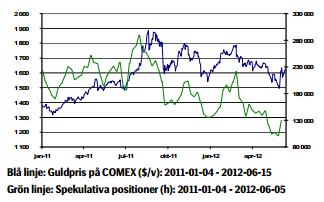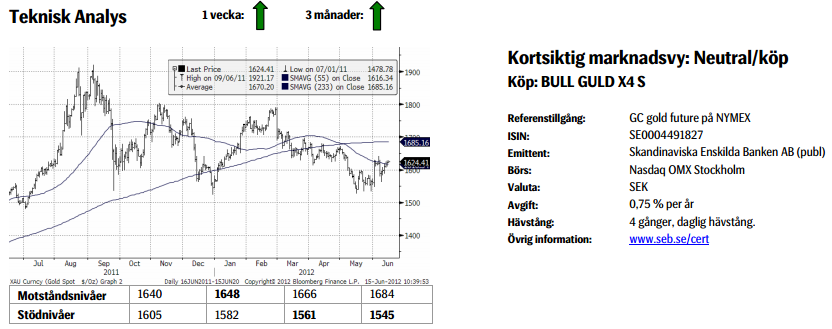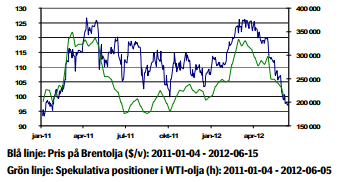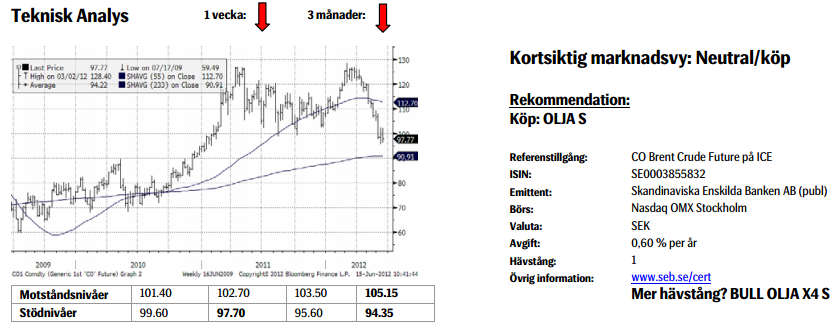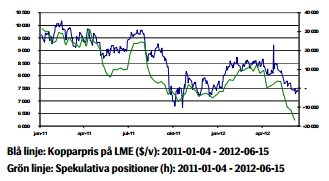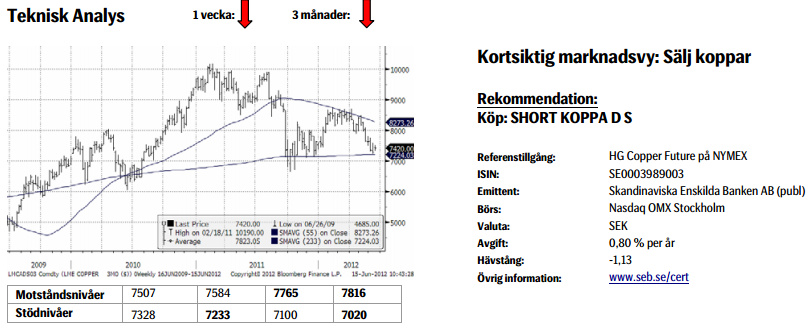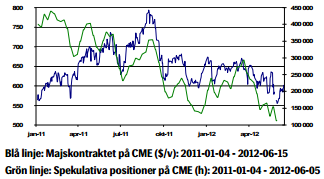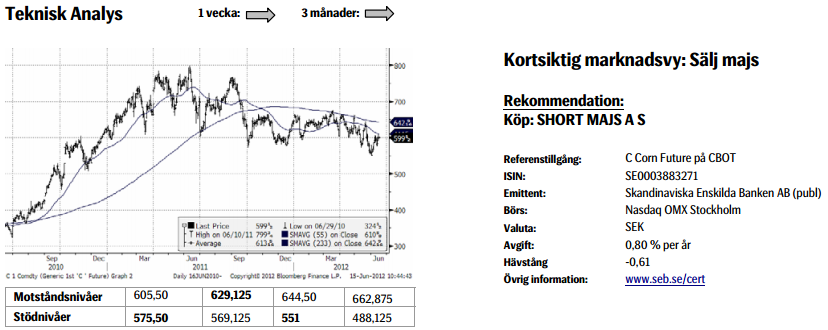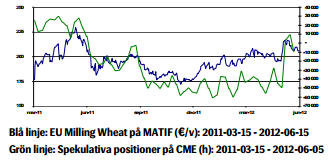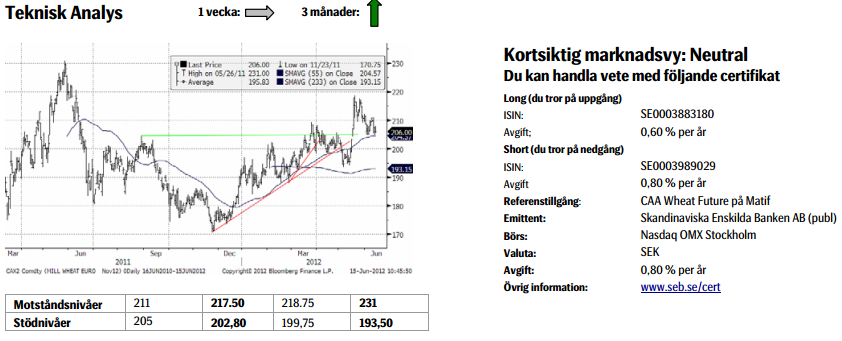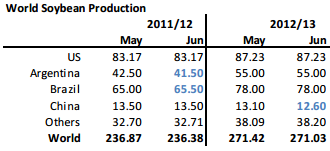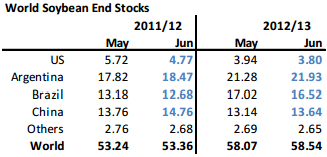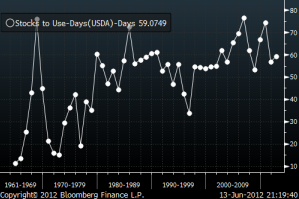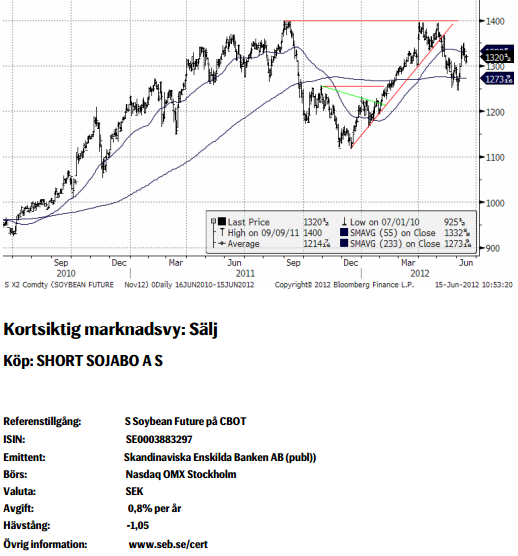Analys
SEB – Råvarukommentarer vecka 24 2012
Sammanfattning: Denna vecka
- Brett råvaruindex: +0,02 %
UBS Bloomberg CMCI TR Index - Energi: +0,45 %
UBS Bloomberg CMCI Energy TR Index - Ädelmetaller:+ 2,06 %
UBS Bloomberg CMCI Precious Metals TR Index - Industrimetaller: +1,23 %
UBS Bloomberg CMCI Industrial Metals TR Index - Jordbruk: -1,67 %
UBS Bloomberg CMCI Agriculture TR Index
Kortsiktig marknadsvy:
- Guld: Neutral/köp
- Olja: Neutral/köp
- Koppar: Sälj
- Majs: Sälj
- Vete: Neutral
- Sojabönor: Sälj
Guld
Vi tycker att man ska vara köpt guld. Förra helgen fick Spanien det lån marknaden länge fruktat men samtidigt hoppats på för att stötta landets krisande banksektor. Lånet uppgick till 100 mdr euro. Guldet reagerade positivt på stimulanspaketet och har stigit två procent under veckan.
Kreditvärderingsinstitutet Fitch sänkte betyget för 18 spanska banker och Moody´s sänkte landets långfristiga kreditbetyg till Baa3 från A3. Igår handlade landets räntor på de högsta nivåerna under euro-tiden. Tioårsräntan steg till 6,99 procent. Stigande räntor i Spanien ökar farhågan att Spanien måste söka ett mer omfattande stöd. Guldet steg åter något på torsdagen då både räntan på tysklands Bund (10-åriga statsobligation) och tyska CDS:er (säkerheter mot en statskonkurs) steg. Brist på förtroende för tyska statspapper är mycket oroande för marknaden.
Oroade blickar riktas även mot Italien som också tyngs att höga räntor. Italiens premiärminister deklarerade dock tydligt i veckan att Italien inte kommer att behöva något räddningspaket eftersom stimulans av tillväxten och ett minskat underskott finns på den italienska agendan.
Råvarubörsen CME minskade marginalkraven för guldterminer med 10 procent i slutet av maj. Sänkningen gav ett visst stöd åt guldpriset men var samtidigt förväntad eftersom marginalkraven är proportionella mot volatilitet och prisnivå. Ökar eller minskar de faktorerna ökar eller minska kraven.
Världens största fysiska guld ETF, SPDR, har sett utflöden för första gången på tre veckor och fonden innehåller nu 1 274,37 ton. Efterfrågan på US Mint coin är fortsatt svag med 53000 ozt i maj (1 troy ounce = ca 31 gram) mot 107 000 ozt i maj 2011.
”Ödesvalet” i Grekland på söndag är en stor osäkerhetsfaktor och vinner den koalition som önskar riva upp besparingskrav kan landet tvingas att lämna euron och osäkerheten om guldet kommer att regera med övriga risktillgångar eller snarare som en säker hamn i orostider är stor.
Teknisk analys: Stadigt högre, igen. Efter en lika oväntad som stor sättning från toppen den sjätte juni har marknaden så sakteliga envist arbetat sig tillbaka upp till de tidigare toppnivåerna. Detta visar med all tydlighet, tycker vi, att nedgången ska etiketteras korrektiv. Det underliggande vågmönstret är också fortsatt positivt varför vi räknar med ytterligare uppgång den närmaste tiden.
Olja
Opec´s 12 medlemsländer höll möte igår i Wien. Saudiarabien har inför mötet begärt en ökning av kartellens produktionsmål som i dagsläget motsvarar 30 miljoner fat per dag., något som går stick i stäv med Opec´s irakiske ordförandes önskningar. Saudiarabien har genom en rekordhög produktion (högsta sedan 1980-talet), verbala påtryckningar fått ner oljepriset till önskvärda100 dollar. Inför mötet har man emellertid taktiskt minskat oljeproduktionen för att undgå kritik för att man producerar mer än tilldelade kvoter. Fortsätter produktionen på aktuell nivå kommer marknaden ha ett överskott på olja under det tredje och fjärde kvartalet i år.
Oförändrade produktionskvoter ger stöd åt oljepriset vilket gynnar de mindre oljeproducerande länderna som haft inkomstbortfall p.g.a. det prisfall vi sett nyligen. Brentpriset föll i veckan till 97,14 dollar, den lägsta nivån sedan januari 2011.
Iran, Venezuela och Angola önskar se ett lägre tak för produktionskvoter. Många länder behöver ett pris på 100 dollar för att kunna balansera sina statsbudgetar.
Saudiarabien är mån om att undvika ett stigande oljepris från en högre säsongsrelaterad efterfrågan och ett från EU:s sida Iranskt embargo som träder ikraft den 1:a juli. Saudiarabien är mycket oroligt för Irans kärnvapenenergiprogram och man vill indirekt inte gynna landet med ett högre oljepris.
Opec behöll emellertid produktionstaket på 30 miljoner fat per dag
Spekulativa positioner i Brent har sjunkit till de lägsta nivåerna sedan november 2011. Efter gårdagen Opec möte är vi neutrala till svagt positiva till ett högre pris men helgens val i Grekland utgör även här en stor osäkerhet. Den tekniska bilden ser emellertid negativ ut.
Teknisk analys: Pass upp för falluckan! Efter en mindre korrektiv uppgång är vi nu redan på väg ner igen. Området runt 96 är av stor vikt och ett brott riskerar att utlösa ytterligare ett ras ned mot 80/85.
Koppar
Kopparpriset fann i bättre än förväntad japansk statistik där maskinordrar, d.v.s. beställningar av maskiner inom industrin, långt överträffade analytikers förväntningar. Kopparn fann även stöd i en ökad kinesisk kopparimport och Shanghaibörsens lager nu är på de lägsta nivåerna sedan januari.
Vi har sett bra statistik från Kina. Exporten för maj växte med 15,3 procent i årstakt vilket var mer än en fördubbling av analytikers förväntan och mer än tre gånger ökningstakten i april.
Kinesiskt konsumentprisindex (inflation) föll något mer än förväntat vilket öppnar upp för möjligheter till ytterligare stimulanser från kinesiska myndigheter vilket ger stöd åt kopparn. Fed ledamöter i USA inleder den 19:e juni ett tvådagarsmöte och skulle man ge marknaden förhoppningar om ytterligare stimulanser kommer detta att påverka kopparn positivt. USA är världens andra största kopparkonsument.
Efter att förra veckan ha varit nära sexmånaderslägsta har kopparpriset nu stigit med 2,6 procent. Framförallt har den positiva statistiken från Kina bidragit.
Valet i Grekland på söndag är en stor osäkerhetsfaktor även för kopparn och en eskalering av krisen i Europa med ett Grekiskt euroutträde kan avsevärt minska riskapptiten. Oron växer även kring Cypern vars ekonomi är tätt sammankopplad med den grekiska. Aktiviteten i marknaden är generellt låg inför valet.
Teknisk analys: På väg mot trend nacklinjen. Inte mycket har hänt sedan förra veckan. En viss stabilisering har dock inträtt men denna bör ses som temporär, en paus i nedåttrenden. Väl avklarad tar vi nästa steg ned emot nacklinjen (av den potentiella huvud skuldra toppformationen).
Majs
Priset på decembermajs fortsätter sin negativa trend som marknaden haft sedan september förra året. Vi fortsätter at räkna med lägre priser och tror att priset kommer att bryta 500 cent för att sedan fortsätta ner.
USDA höjde produktionsestimatet för 2012/13. Rapporten räknar även med att utgående majslager ökar. Efterfrågan från Kina och andra tillväxtländer samt efterfrågan på majs till etanoltillverkning har hållit lagren pressade. När det gäller etanol är ökningen i efterfrågan med största sannolikhet över.
USDA reviderar upp sin prognos för Rysslands majsproduktion 2012/13 och den beräknade produktionen slår därmed det tidigare produktionsrekordet från 2008/09 som även matchades 2011/12.
Majsproduktionen i Kina 2012/13 beräknas vara oförändrad jämfört med förra året. Lantbrukarna i landet förväntas öka majsarealen p.g.a. lägre vinstmarginaler för andra grödor.
Teknisk analys: Upp inom kanalen. Den övergripande bilden är fortfarande rätt svårtydd. Dock kan vi noterar att det falska brottet på nedsidan vid månadsskiftet har lett till ett normalt utfall, ett återtest av golvet med på följande uppgång. Troligtvis kommer kraften i studsen att räcka till ungefär 630. Faller vi under 575 ½ så är studsen redan över och ett nytt bottentest på väg.
Vete
Det USDA har publicerat juni månads WASDE (World Agricultural Supply and Demand Estimates) rapport för produktion, konsumtion och utgående lager. Prognosen för den globala veteproduktionen 2012/13 visar en nedjustering från förra säsongen till 680 ton, vilket dock är fem ton högre än tidigare prognos och fortfarande en bra bit över genomsnittet de senaste fem åren.
Det europeiska Matifvetet föll tillbaka efter Wasde-rapporten. Vi har en negativ grundsyn på prisutvecklingen.
Skicket (crop condition) på amerikanskt vintervete som rapporterade i måndags ligger på 53 % /good/excellent, vilket är en procent högre än förra veckan.
Globala vetelager är på en relativt låg nivå och förväntas inte stiga 2012/13. Nedsiderisken är alltså begränsad.
Ryssland som är en viktig veteproducent har haft problem med ihållande torka och varma temperaturer under april och större delen av maj vilket har hämmat grödornas utveckling.
Dessutom har ogynnsamma väderförhållanden i Centraleuropa gör att USDA reviderat ned produktionsestimat.
Vi fortsätter att ha en neutral syn på veteprisets utveckling på kort sikt.
Teknisk analys: Tillbaka i 55dagars bandet. Tanken om en fortsatt uppgång har, givet de senaste dagarnas nedgång, skjutits på framtiden. Återigen ligger fokus på huruvida köparna kommer, att som vanligt, återkomma i 55dagars bandet eller inte? Om vi följer det tidigare mönstret bör vi snart försöka högre igen.
Sojabönor
Nedan ser vi WASDE-rapportens produktionsestimat i miljoner ton, som publicerades i onsdags. Det är inga större förändringar för innevarande år, dock en liten uppjustering av Brasiliens skörd och en lika stor nedjustering av Argentinas. För 2012/13 justerades endast Kinas produktion nedåt.
Utgående lager ser vi nedan. Det är otroligt låga utgående lagerestimat för USA. Globalt är dock lagren på en hyggligt bra nivå.
Nedan ser vi nuvarande utgående lager i historiskt perspektiv. Lager som räcker i 59 dagar är en relativt hög nivå, trots allt.
Lägre ekonomisk tillväxt runtom i världen tynger sojabönorna. Vi ser ett lite längre prisdiagram på novemberkontraktet nedan. Så länge det inte blir någon störning av höstens sådd i Sydamerika bör priset kunna hålla sig under 1400 cent. Vi tycker att man ska vara såld sojabönor nu, med stop-loss på drygt 1400 cent. Det finns goda möjligheter till lägre priser framöver.
[box]SEB Veckobrev Veckans råvarukommentar är producerat av SEB Merchant Banking och publiceras i samarbete och med tillstånd på Råvarumarknaden.se[/box]
Disclaimer
The information in this document has been compiled by SEB Merchant Banking, a division within Skandinaviska Enskilda Banken AB (publ) (“SEB”).
Opinions contained in this report represent the bank’s present opinion only and are subject to change without notice. All information contained in this report has been compiled in good faith from sources believed to be reliable. However, no representation or warranty, expressed or implied, is made with respect to the completeness or accuracy of its contents and the information is not to be relied upon as authoritative. Anyone considering taking actions based upon the content of this document is urged to base his or her investment decisions upon such investigations as he or she deems necessary. This document is being provided as information only, and no specific actions are being solicited as a result of it; to the extent permitted by law, no liability whatsoever is accepted for any direct or consequential loss arising from use of this document or its contents.
About SEB
SEB is a public company incorporated in Stockholm, Sweden, with limited liability. It is a participant at major Nordic and other European Regulated Markets and Multilateral Trading Facilities (as well as some non-European equivalent markets) for trading in financial instruments, such as markets operated by NASDAQ OMX, NYSE Euronext, London Stock Exchange, Deutsche Börse, Swiss Exchanges, Turquoise and Chi-X. SEB is authorized and regulated by Finansinspektionen in Sweden; it is authorized and subject to limited regulation by the Financial Services Authority for the conduct of designated investment business in the UK, and is subject to the provisions of relevant regulators in all other jurisdictions where SEB conducts operations. SEB Merchant Banking. All rights reserved.
Analys
Brent crude ticks higher on tension, but market structure stays soft

Brent crude has climbed roughly USD 1.5-2 per barrel since Friday, yet falling USD 0.3 per barrel this mornig and currently trading near USD 67.25/bbl after yesterday’s climb. While the rally reflects short-term geopolitical tension, price action has been choppy, and crude remains locked in a broader range – caught between supply-side pressure and spot resilience.

Prices have been supported by renewed Ukrainian drone strikes targeting Russian infrastructure. Over the weekend, falling debris triggered a fire at the 20mtpa Kirishi refinery, following last week’s attack on the key Primorsk terminal.
Argus estimates that these attacks have halted ish 300 kbl/d of Russian refining capacity in August and September. While the market impact is limited for now, the action signals Kyiv’s growing willingness to disrupt oil flows – supporting a soft geopolitical floor under prices.
The political environment is shifting: the EU is reportedly considering sanctions on Indian and Chinese firms facilitating Russian crude flows, while the U.S. has so far held back – despite Bessent warning that any action from Washington depends on broader European participation. Senator Graham has also publicly criticized NATO members like Slovakia and Hungary for continuing Russian oil imports.
It’s worth noting that China and India remain the two largest buyers of Russian barrels since the invasion of Ukraine. While New Delhi has been hit with 50% secondary tariffs, Beijing has been spared so far.
Still, the broader supply/demand balance leans bearish. Futures markets reflect this: Brent’s prompt spread (gauge of near-term tightness) has narrowed to the current USD 0.42/bl, down from USD 0.96/bl two months ago, pointing to weakening backwardation.
This aligns with expectations for a record surplus in 2026, largely driven by the faster-than-anticipated return of OPEC+ barrels to market. OPEC+ is gathering in Vienna this week to begin revising member production capacity estimates – setting the stage for new output baselines from 2027. The group aims to agree on how to define “maximum sustainable capacity,” with a proposal expected by year-end.
While the IEA pegs OPEC+ capacity at 47.9 million barrels per day, actual output in August was only 42.4 million barrels per day. Disagreements over data and quota fairness (especially from Iraq and Nigeria) have already delayed this process. Angola even quit the group last year after being assigned a lower target than expected. It also remains unclear whether Russia and Iraq can regain earlier output levels due to infrastructure constraints.
Also, macro remains another key driver this week. A 25bp Fed rate cut is widely expected tomorrow (Wednesday), and commodities in general could benefit a potential cut.
Summing up: Brent crude continues to drift sideways, finding near-term support from geopolitics and refining strength. But with surplus building and market structure softening, the upside may remain capped.
Analys
Volatile but going nowhere. Brent crude circles USD 66 as market weighs surplus vs risk

Brent crude is essentially flat on the week, but after a volatile ride. Prices started Monday near USD 65.5/bl, climbed steadily to a mid-week high of USD 67.8/bl on Wednesday evening, before falling sharply – losing about USD 2/bl during Thursday’s session.

Brent is currently trading around USD 65.8/bl, right back where it began. The volatility reflects the market’s ongoing struggle to balance growing surplus risks against persistent geopolitical uncertainty and resilient refined product margins. Thursday’s slide snapped a three-day rally and came largely in response to a string of bearish signals, most notably from the IEA’s updated short-term outlook.
The IEA now projects record global oversupply in 2026, reinforcing concerns flagged earlier by the U.S. EIA, which already sees inventories building this quarter. The forecast comes just days after OPEC+ confirmed it will continue returning idle barrels to the market in October – albeit at a slower pace of +137,000 bl/d. While modest, the move underscores a steady push to reclaim market share and adds to supply-side pressure into year-end.
Thursday’s price drop also followed geopolitical incidences: Israeli airstrikes reportedly targeted Hamas leadership in Doha, while Russian drones crossed into Polish airspace – events that initially sent crude higher as traders covered short positions.
Yet, sentiment remains broadly cautious. Strong refining margins and low inventories at key pricing hubs like Europe continue to support the downside. Chinese stockpiling of discounted Russian barrels and tightness in refined product markets – especially diesel – are also lending support.
On the demand side, the IEA revised up its 2025 global demand growth forecast by 60,000 bl/d to 740,000 bl/d YoY, while leaving 2026 unchanged at 698,000 bl/d. Interestingly, the agency also signaled that its next long-term report could show global oil demand rising through 2050.
Meanwhile, OPEC offered a contrasting view in its latest Monthly Oil Market Report, maintaining expectations for a supply deficit both this year and next, even as its members raise output. The group kept its demand growth estimates for 2025 and 2026 unchanged at 1.29 million bl/d and 1.38 million bl/d, respectively.
We continue to watch whether the bearish supply outlook will outweigh geopolitical risk, and if Brent can continue to find support above USD 65/bl – a level increasingly seen as a soft floor for OPEC+ policy.
Analys
Waiting for the surplus while we worry about Israel and Qatar

Brent crude makes some gains as Israel’s attack on Hamas in Qatar rattles markets. Brent crude spiked to a high of USD 67.38/b yesterday as Israel made a strike on Hamas in Qatar. But it wasn’t able to hold on to that level and only closed up 0.6% in the end at USD 66.39/b. This morning it is starting on the up with a gain of 0.9% at USD 67/b. Still rattled by Israel’s attack on Hamas in Qatar yesterday. Brent is getting some help on the margin this morning with Asian equities higher and copper gaining half a percent. But the dark cloud of surplus ahead is nonetheless hanging over the market with Brent trading two dollar lower than last Tuesday.

Geopolitical risk premiums in oil rarely lasts long unless actual supply disruption kicks in. While Israel’s attack on Hamas in Qatar is shocking, the geopolitical risk lifting crude oil yesterday and this morning is unlikely to last very long as such geopolitical risk premiums usually do not last long unless real disruption kicks in.
US API data yesterday indicated a US crude and product stock build last week of 3.1 mb. The US API last evening released partial US oil inventory data indicating that US crude stocks rose 1.3 mb and middle distillates rose 1.5 mb while gasoline rose 0.3 mb. In total a bit more than 3 mb increase. US crude and product stocks usually rise around 1 mb per week this time of year. So US commercial crude and product stock rose 2 mb over the past week adjusted for the seasonal norm. Official and complete data are due today at 16:30.
A 2 mb/week seasonally adj. US stock build implies a 1 – 1.4 mb/d global surplus if it is persistent. Assume that if the global oil market is running a surplus then some 20% to 30% of that surplus ends up in US commercial inventories. A 2 mb seasonally adjusted inventory build equals 286 kb/d. Divide by 0.2 to 0.3 and we get an implied global surplus of 950 kb/d to 1430 kb/d. A 2 mb/week seasonally adjusted build in US oil inventories is close to noise unless it is a persistent pattern every week.
US IEA STEO oil report: Robust surplus ahead and Brent averaging USD 51/b in 2026. The US EIA yesterday released its monthly STEO oil report. It projected a large and persistent surplus ahead. It estimates a global surplus of 2.2 m/d from September to December this year. A 2.4 mb/d surplus in Q1-26 and an average surplus for 2026 of 1.6 mb/d resulting in an average Brent crude oil price of USD 51/b next year. And that includes an assumption where OPEC crude oil production only averages 27.8 mb/d in 2026 versus 27.0 mb/d in 2024 and 28.6 mb/d in August.
Brent will feel the bear-pressure once US/OECD stocks starts visible build. In the meanwhile the oil market sits waiting for this projected surplus to materialize in US and OECD inventories. Once they visibly starts to build on a consistent basis, then Brent crude will likely quickly lose altitude. And unless some unforeseen supply disruption kicks in, it is bound to happen.
US IEA STEO September report. In total not much different than it was in January
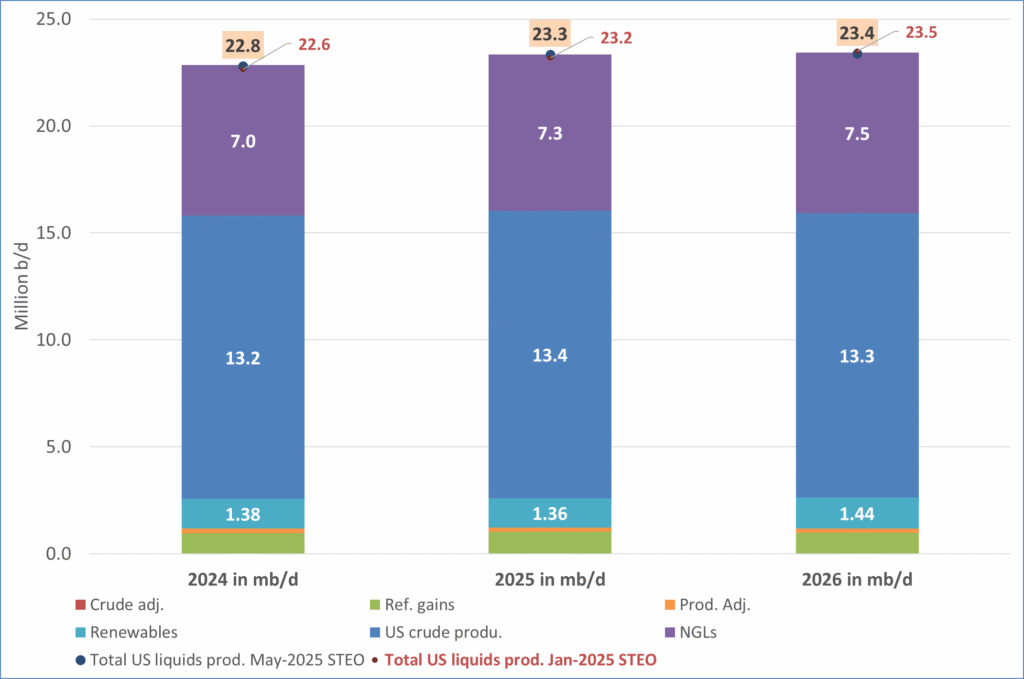
US IEA STEO September report. US crude oil production contracting in 2026, but NGLs still growing. Close to zero net liquids growth in total.
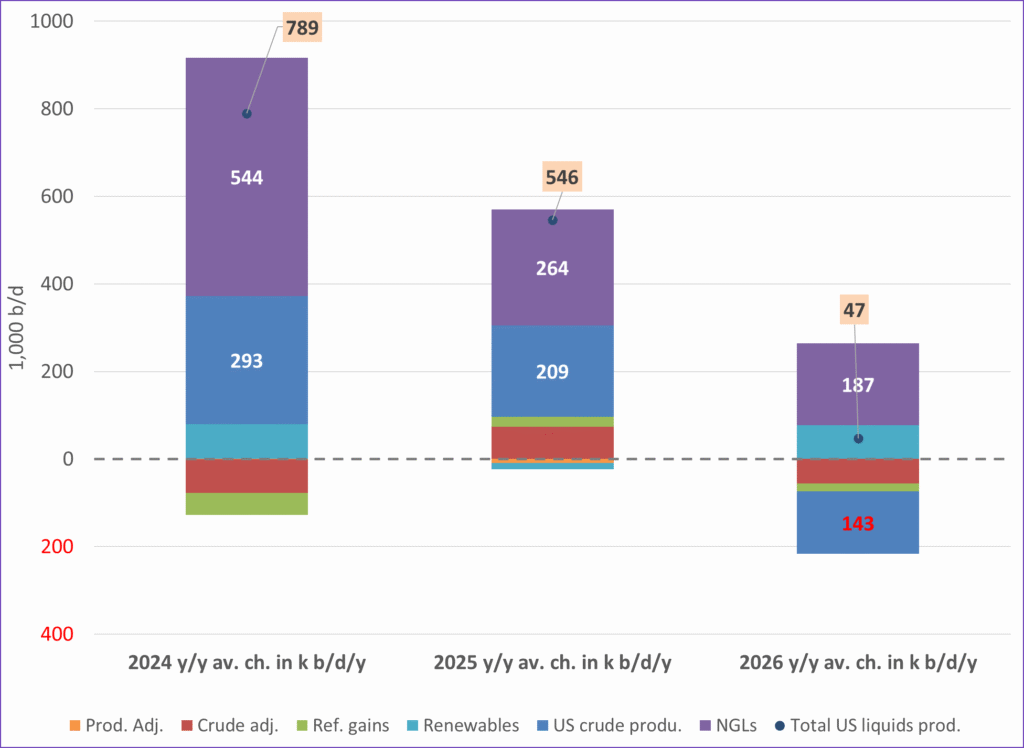
-

 Nyheter4 veckor sedan
Nyheter4 veckor sedanMeta bygger ett AI-datacenter på 5 GW och 2,25 GW gaskraftverk
-
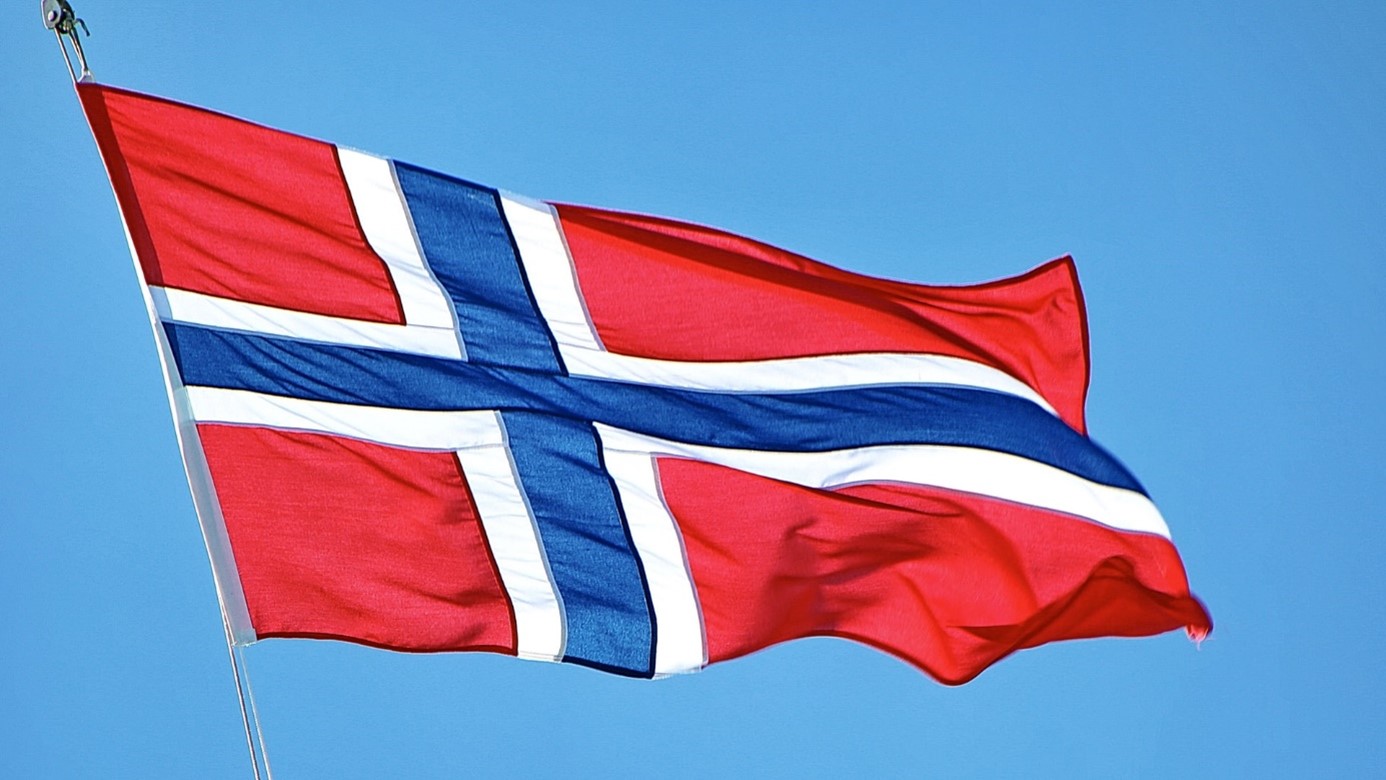
 Nyheter4 veckor sedan
Nyheter4 veckor sedanAker BP gör ett av Norges största oljefynd på ett decennium, stärker resurserna i Yggdrasilområdet
-

 Nyheter4 veckor sedan
Nyheter4 veckor sedanSommarens torka kan ge högre elpriser i höst
-

 Analys4 veckor sedan
Analys4 veckor sedanBrent edges higher as India–Russia oil trade draws U.S. ire and Powell takes the stage at Jackson Hole
-
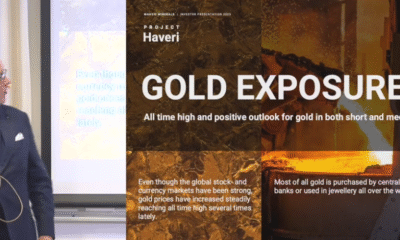
 Nyheter3 veckor sedan
Nyheter3 veckor sedanMahvie Minerals är verksamt i guldrikt område i Finland
-

 Analys3 veckor sedan
Analys3 veckor sedanIncreasing risk that OPEC+ will unwind the last 1.65 mb/d of cuts when they meet on 7 September
-

 Nyheter3 veckor sedan
Nyheter3 veckor sedanNeil Atkinson spår att priset på olja kommer att stiga till 70 USD
-

 Analys2 veckor sedan
Analys2 veckor sedanOPEC+ in a process of retaking market share



